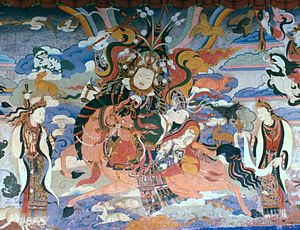| Fromo Kesaro ϕρoµo κησαρo "Rome Caesar" | |
|---|---|
| Majestic Sovereign | |
 Sasanian-style silver coin of Fromo Kesaro, circa 738-745 CE. Corrupted legend spwl in Pahlavi. In the outer margin in Bactrian: ϕρoµo κησαρo βαγo χoαδηo phromo kesaro zeoro bago xodeo "Fromo Kesaro, the Majestic Sovereign".[1] | |
| Turk Shahi King | |
| Reign | 739-745 CE |
| Predecessor | Tegin Shah |
| Successor | Bo Fuzhun |

Approximate location of the Turk Shahis

Fromo or Phromo Kesaro (Bactrian script: ϕρoµo κησαρo, phonetical transcription of "Rome Caesar") was a king of the Turk Shahis (also known as the Kabul Shahis), a dynasty of Western Turk or mixed Western Turk-Hephthalite origin, who ruled from Kabul and Kapisa to Gandhara in the 7th to 9th centuries.[3] In Chinese sources "Fromo Kesaro" was transcribed 拂菻罽娑 (pinyin: Fulin Jisuo; jyutping: fat1lam4 gai3so1), "Fulin" (拂菻) being the standard Tang dynasty name for "Byzantine Empire".[4][5][6]
- ^ a b Dani, Ahmad Hasan; Litvinsky, B. A. (1 January 1996). History of Civilizations of Central Asia: The crossroads of civilizations, A.D. 250 to 750. UNESCO. p. 380. ISBN 978-92-3-103211-0.
The legends are written only in Bactrian and Pahlavi scripts and languages. They run as follows: obverse (11 h) (1) GDH (2) 'p < zwt > (2 h) (1) bg (2) h. wtyp (The glory increased! The Majestic Sovereign); on the rim around, ϕρoµo κησαρo βαγo χoαδηo (Fromo Kesaro, the Majestic Sovereign); reverse (10 h) ŠT' (2 h) h. wndy ([minted in his] 6th [regnal year at] Hund).
- ^ Readings with photographs in "New Coins of Fromo Kēsaro" by Helmut Humbach in: G. Pollet (ed.), "India and the Ancient World. History, trade and culture before A.D. 650". Professor P.H.L. Eggermont jubilee volume. Leuven 1987, 81-85, plates. XI-XIII
- ^ Kim, Hyun Jin (19 November 2015). The Huns. Routledge. pp. 58–59. ISBN 978-1-317-34090-4.
- ^ Rahman, Abdur; Bopearachchi (Ed.), Osmund; Boussac (Ed.), Marie-Françoise (2002). Afghanistan. Ancien Carrefour entre l'Est et l'Ouest (New Light on Khingal, Turk and Hindu Shahis) (PDF). Vol. XV. Turnhout, Belgium: Brepols. pp. 37–41. ISBN 2-503-51681-5.
- ^ Inaba, Minoru; Balogh, Dániel (2020). "The legend of Xinnie in the seventh and eighth centuries". In Balogh, Dániel (ed.). Hunnic Peoples in Central and South Asia: Sources for their Origin and History. Barkhuis. pp. 103–107. ISBN 978-9-493-19401-4.
- ^ Piras, Andrea. "FROMO KESARO. Echi del prestigio di Bisanzio in Asia Centrale, in Polidoro. Studi offerti ad Antonio Carile, a cura di G. Vespignani (Centro italiano di Studi sull'Alto Medioevo), Spoleto 2013, pp. 671-690": 681.
{{cite journal}}: Cite journal requires|journal=(help)
© MMXXIII Rich X Search. We shall prevail. All rights reserved. Rich X Search

